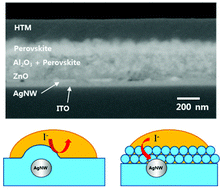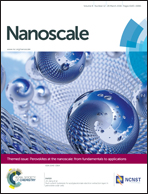Fully solution-processed transparent electrodes based on silver nanowire composites for perovskite solar cells†
Abstract
We report all-solution-processed transparent conductive electrodes based on Ag nanowire (AgNW)-embedded metal oxide composite films for application in organometal halide perovskite solar cells. To address the thermal instability of Ag nanowires, we used combustive sol–gel derived thin films to construct ZnO/ITO/AgNW/ITO composite structures. The resulting composite configuration effectively prevented the AgNWs from undergoing undesirable side-reactions with halogen ions present in the perovskite precursor solutions that significantly deteriorate the optoelectrical properties of Ag nanowires in transparent conductive films. AgNW-based composite electrodes had a transmittance of ∼80% at 550 nm and sheet resistance of 18 Ω sq−1. Perovskite solar cells fabricated using a fully solution-processed transparent conductive electrode, Au/spiro-OMeTAD/CH3NH3PbI3 + m-Al2O3/ZnO/ITO/AgNW/ITO, exhibited a power conversion efficiency of 8.44% (comparable to that of the FTO/glass-based counterpart at 10.81%) and were stable for 30 days in ambient air. Our results demonstrate the feasibility of using AgNWs as a transparent bottom electrode in perovskite solar cells produced by a fully printable process.

- This article is part of the themed collection: Perovskites at the nanoscale: from fundamentals to applications

 Please wait while we load your content...
Please wait while we load your content...